Lowering the GDP growth projection for the current fiscal to 5.5% from 5.7%, the central bank said the external sector is the "biggest threat" to economic stability.
It also said that the recent liquidity tightening measures, taken to support the rupee, will be rolled back in a calibrated manner as stability is restored to the foreign exchange market, enabling it to revert to the policy of supporting growth with continuing vigil on inflation.
The RBI will endeavour to keep inflation, which is under threat from a depreciating rupee, at 5% by March end.
ALSO READ: RBI squeezes liquidity further
"The policy stance is guided by the need for continuous vigil and preparedness to pro-actively respond to risks to the economy from external developments, especially those stemming from global financial markets," Governor D Subbarao said in what would be his last policy announcement unveiled here.
Accordingly, the repo rate or the rate at which RBI lends to the system, has been retained at 7.25% and the cash reserve ratio, the amount of deposits banks park with RBI, has been kept unchanged at 4%.
Giving the policy guidance, the governor said "monetary policy going forward will be shaped by the consideration of supporting growth, anchoring inflation expectations and maintaining external sector stability."
Subbarao, who is slated to retire days before the next mid-quarter review on September 18, said the policy stance is aimed at addressing risks to macroeconomic stability and growth and guard against the re-emergence of inflationary pressure.
It would also endeavour to manage liquidity conditions to ensure adequate credit flow to productive sectors of the economy.
The current situation of low headline inflation, prospects of softening food inflation on a good monsoon and decelerating growth warranted a pro-growth policy stance, but for the difficulties on the external front, as reflected in the almost 10% depreciation in the rupee and the rising current account deficit, he said.
Stating that the external sector was the "biggest risk to macroeconomic stability," Subbarao called for urgent policy steps from the government to curtail the CAD to a sustainable level of 2.5% of GDP and said that the RBI is ready to use all instruments under its command help in the efforts.
ALSO READ: RBI tightens gold import norms to squeeze CAD
"It should be emphasised that the time available now should be used with alacrity to institute structural measures to bring CAD down to sustainable levels," the Governor said.
The recent liquidity tightening measures, brought in to reduce speculative pressures on the rupee, which had hit a record low of 61.21 to the dollar on July 8, will be rolled back once the currency stabilises, which will lead to a shift in the monetary policy to be more accommodative and pro-growth, he added.
On inflation, while Subbarao acknowledged the ongoing rupee depreciation would create trouble for the price rise scenario, he stressed that the RBI will use all instruments at its disposal to contain it to 5% by March.
Inflation as measured by wholesale prices increased marginally to 4.86% in June.
The Governor termed the consistently high CAD, which came in at 4.8% last fiscal, as a "formidable structural risk" leading to increased stress on balance of payments and reflecting rising external indebtedness.
Over the next 6-12 months, $174 billion of external debt has to be repaid, while depleting foreign-exchange reserves, which stood at $280 billion as of last week, have reduced the import cover buffer to about six months.
Additionally, the Governor said the growing vulnerability in the external sector also "reinforces the importance of (the need to bring in) credible fiscal consolidation."
ALSO READ: RBI clamps down on easy money, again
Subbarao said growth can be sustained in the medium term only on the back of low and stable inflation and he reiterated the need to ease supply-side constraints.
"Without policy efforts to address the deterioration in productivity and competitiveness, the pressures from wage increases and upward revisions in administered prices could weaken growth further and exacerbate inflation pressures," he said.
The second quarter monetary policy is scheduled on October 29, while the next mid-quarter review will be released on September 18.

)
